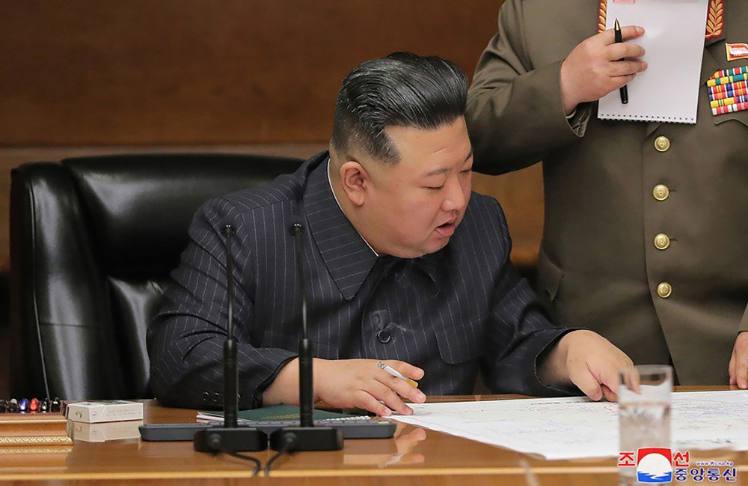
By Brad Lendon and Yoonjung Seo, CNN
Seoul, South Korea (CNN) — North Korea on Wednesday fired an intercontinental ballistic missile that flew for more than 70 minutes, Japan’s Defense Ministry said, marking a potential new round of confrontation with Washington and its allies.
The 74-minute flight time represents a marginal advancement on the missiles tested by North Korea in March and April of this year, both of which were also ICBMs – weapons with the required range to potentially hit the continental United States.
Wednesday’s launch, which landed in waters near to Japan, comes after Pyongyang earlier this week threatened to shoot down US military reconnaissance aircraft engaging in what it called “hostile espionage” activities near its territory.
The missile launch and fiery rhetoric, while not unusual for Pyongyang, arrives during a period of heightened tensions on the peninsula, as Washington and Seoul ramp up their defense cooperation. It also appears timed to coincide with the NATO summit in Lithuania, where leaders from South Korea, Japan and the US are meeting to discuss security issues – including the threat posed by North Korea.
The latest missile launch, the country’s first in three months, flew a distance of 1,000 kilometers (621 miles) and at an altitude of over 6,000 kilometers (3,700 miles), Japan’s Defense Ministry said.
Flight times give an indication of a missile’s range. North Korea tests most of its missiles on a highly lofted trajectory so they splash down in nearby waters, rather than a flatter trajectory as would be used in an actual attack.
Japan’s Coast Guard said earlier the missile was launched at 9:59 a.m. local time and fell into the Sea of Japan, also known as the East Sea, at 11:15 a.m., citing the Ministry of Defense.
Some experts say North Korea likely tested its developmental, road-mobile Hwasong-18 ICBM, a type of solid-fuel weapon that is harder to detect and intercept than the North’s other liquid-fuel ICBMs. North Korean leader Kim Jong Un previously called the Hwasong-18 his most powerful nuclear weapon – though there is no indication the missile can successfully deliver a nuclear payload.
“North Korea’s launch seems to be its second test of the Hwasong-18 ICBM which was first fired on April 13. North Korea seems to be continuously advancing the missile technology based on the first test launch result,” said Kim Dong-yub, a professor at the University of North Korean Studies in Seoul.
South Korean President Yoon Suk Yeol held an emergency National Security Council meeting in Lithuania on Wednesday morning in response to the missile launch, Yoon’s press office said in a statement. Yoon is in Vilnius to attend the NATO summit.
The South Korean leader said that he would call for “strong international solidarity” at the NATO summit in response to North Korea’s launch, according to his office.
US condemns ‘brazen’ test
Washington condemned North Korea’s missile test, with US National Security Council spokesperson Adam Hodge calling it “a brazen violation of multiple UN Security Council resolutions and needlessly raises tensions and risks destabilizing the security situation in the region.”
Hodge called on all countries to condemn the violation and call on North Korea to “come to the table for serious negotiations.”
“The door has not closed on diplomacy, but Pyongyang must immediately cease its destabilizing actions and instead choose diplomatic engagement. The United States will take all necessary measures to ensure the security of the American homeland and Republic of Korea and Japanese allies.”
A communique from the NATO meeting on Tuesday urged North Korea to abandoned its ballistic missile and nuclear weapons programs.
“We call on (North Korea) to accept the repeated offers of dialogue put forward by all parties concerned, including Japan, the United States, and the Republic of Korea,” the communique said.
But North Korea has shown no signs that it is willing to engage in negotiations with Washington or Seoul.
Wednesday’s ICBM test follows threats from Kim Yo Jong, a senior North Korean official and sister of North Korean leader Kim Jong Un, who accused a US spy plane of entering the North’s exclusive economic zone at least eight times on Monday.
“In case of repeated illegal intrusion, the US forces will experience a very critical flight,” Kim warned in a statement Tuesday from North Korea’s state news agency.
The US and South Korea dismissed the accusations and urged North Korea to stop creating tension with false claims.
Leif-Eric Easley, associate professor of international studies at Ewha Womans University in Seoul, said that Kim’s accusations are part of a North Korean pattern of inflating external threats to rally domestic support and justify weapons tests.
“Pyongyang also times its shows of force to disrupt what it perceives as diplomatic coordination against it, in this case, South Korea and Japan’s leaders meeting during the NATO summit,” said Easley.
Last month, tens of thousands of North Koreans marched in anti-US rallies in Pyongyang, marking the 73rd anniversary of the start of the Korean War. The participants denounced the US as “Destroyer of peace and stability of the Korean Peninsula” and warned of nuclear war, according to state nedia.
Meanwhile, South Korea, the US and Japan have been holding joint and trilateral military exercises aimed at deterring any North Korean military threat.
Wednesday’s launch comes two weeks before North Korea is due to celebrate the 70th anniversary of the Korean Armistice Agreement, that brought about a cessation of hostilities of the Korean War, and weeks after its failed launch of the first spy satellite in May.
The-CNN-Wire
™ & © 2023 Cable News Network, Inc., a Warner Bros. Discovery Company. All rights reserved.















